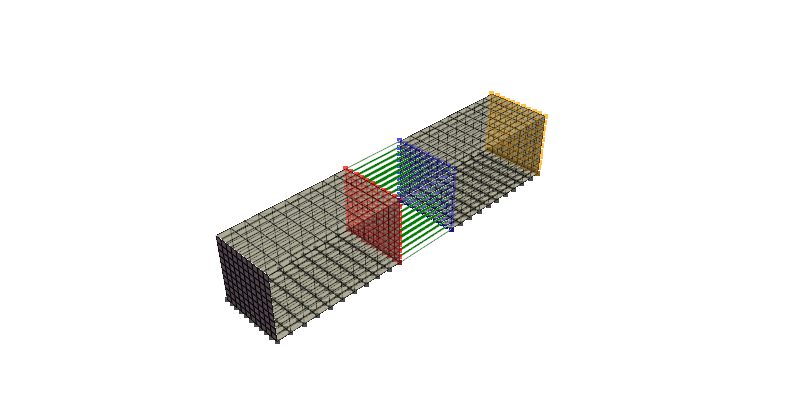Adding Discrete sets¶
Load main libraries, set paths and adjust plotting theme (optional)
[1]:
from pathlib import Path
import numpy as np
import pyvista as pv
pv.set_jupyter_backend('static')
pv.global_theme.background = 'white'
pv.global_theme.color = "beige"
pv.global_theme.show_edges = True
pv.global_theme.window_size = [800, 400]
STATICS_DIR = Path("../../../../_static")
HEXBEAM_MULTIBLOCK_FILEPATH = STATICS_DIR / "hexbeam_multiblock_discrete_case_1.vtm"
Load the Mesh¶
In this examples, we are simply interested in manipulating the FEB file and not the mesh itself, therefore we will be used pre-defined mesh. If you wish to create the mesh using python, we recommend using the pyvista or the gmsh and pygmsh libraries.
[2]:
mb = pv.read(HEXBEAM_MULTIBLOCK_FILEPATH)
mb
[2]:
| Information | Blocks | ||||||||||||||||||||||
|---|---|---|---|---|---|---|---|---|---|---|---|---|---|---|---|---|---|---|---|---|---|---|---|
|
|
Extract each block from the multiblock
[3]:
first_block = mb["first_block"]
second_block = mb["second_block"]
selected_load_surface = mb["selected_load_surface"]
Extract the field data (just to make it easier later on)
[4]:
first_block_discrete_ids = first_block.field_data["discrete_ids"]
second_block_discrete_ids = second_block.field_data["discrete_ids"]
first_block_ground_ids = first_block.field_data["ground_ids"]
second_block_ground_ids = second_block.field_data["ground_ids"]
second_block_boundary_ids = second_block.field_data["boundary_ids"]
load_surface_connectivity = selected_load_surface.field_data["load_surface_connectivity"]
Create lines (for visualization only)
[5]:
src_points = first_block.points[first_block_discrete_ids]
dst_points = second_block.points[second_block_discrete_ids]
lines = np.stack((src_points, dst_points), axis=1).reshape(-1, 3)
Plot the data
[6]:
plotter = pv.Plotter()
plotter.add_mesh(first_block, color="beige", opacity=0.7)
plotter.add_mesh(second_block, color="beige", opacity=0.7)
plotter.add_points(first_block.points[first_block_discrete_ids], color="red", point_size=5, opacity=0.7)
plotter.add_points(second_block.points[second_block_discrete_ids], color="blue", point_size=5, opacity=0.7)
plotter.add_lines(lines, color="green", width=1)
plotter.add_points(first_block.points[first_block_ground_ids], color="black", point_size=5, opacity=0.7)
plotter.add_points(second_block.points[second_block_ground_ids], color="black", point_size=5, opacity=0.7)
plotter.add_points(second_block.points[second_block_boundary_ids], color="orange", point_size=5, opacity=0.7)
plotter.add_mesh(selected_load_surface, color="purple", point_size=6)
plotter.show()

Create FEB¶
Create a FEB object:¶
[7]:
from febio_python import Feb
feb = Feb(version=3.0)
Setup basic configurations:¶
[8]:
feb.setup_module(module_type="solid") # default values
feb.setup_globals(T=0, R=0, Fc=0) # default values
feb.setup_controls(analysis="dynamic") # here, you can change basic settings. See docs for more info.
feb.setup_output(variables=["displacement", "Lagrange strain", "stress"]) # default values
Add materials¶
[9]:
from febio_python.core import Material
# Define the block materials
# first block material
material_1 = Material(
id=1,
type="isotropic elastic",
name="FirstBlockMaterial",
parameters=dict(
E=2e3,
v=0.3,
density=1,
)
)
# second block material
material_2 = Material(
id=2,
type="isotropic elastic",
name="SecondBlockMaterial",
parameters=dict(
E=1e3,
v=0.25,
density=1,
)
)
Add the material to the FEB object
[10]:
feb.add_materials([material_1, material_2])
Add mesh¶
[11]:
from febio_python.core import Nodes, Elements
# Define the nodes
first_block_nodes_obj = Nodes(name="FirstBlockNodes", coordinates=first_block.points)
second_block_nodes_obj = Nodes(name="SecondBlockNodes", coordinates=second_block.points)
# Define the elements
first_block_elements = Elements(
name="FirstBlockElements",
type="HEXAHEDRON",
connectivity=first_block.cells_dict[pv.CellType.HEXAHEDRON],
mat=1
)
second_block_elements = Elements(
name="SecondBlockElements",
type="HEXAHEDRON",
connectivity=second_block.cells_dict[pv.CellType.HEXAHEDRON] + first_block.n_points, # we need to offset the indices
mat=2
)
Add the nodes and elements to the FEB object
[12]:
feb.add_nodes([first_block_nodes_obj, second_block_nodes_obj])
feb.add_elements([first_block_elements, second_block_elements])
Add Mesh Domains¶
[13]:
from febio_python.core import SolidDomain
# create a solid domain
solid_1 = SolidDomain(
id=1,
name="FirstBlockElements", # this must match one of the element names
mat="FirstBlockMaterial", # this must match one of the material names
)
solid_2 = SolidDomain(
id=2,
name="SecondBlockElements", # this must match one of the element names
mat="SecondBlockMaterial", # this must match one of the material names
)
Add domains to the FEB object
[14]:
feb.add_mesh_domains([solid_1, solid_2])
Add Nodesets¶
[15]:
from febio_python.core import NodeSet
# Define the node sets
boundary_nodeset = NodeSet(
name="BoundaryNodes",
ids=second_block_boundary_ids + first_block.n_points # since this is the second block, we need to offset the ids
)
first_block_ground_nodeset = NodeSet(
name="FirstBlockGroundNodes",
ids=first_block_ground_ids
)
second_block_ground_nodeset = NodeSet(
name="SecondBlockGroundNodes",
ids=second_block_ground_ids + first_block.n_points # since this is the second block, we need to offset the ids
)
Add node sets to the FEB object
[16]:
feb.add_node_sets([boundary_nodeset, first_block_ground_nodeset, second_block_ground_nodeset])
Add Surfaces¶
[17]:
from febio_python.core import Surfaces
# Define the surface
surface = Surfaces(
name="LoadSurface",
type="QUAD",
connectivity=load_surface_connectivity,
)
Add surface to the FEB object
[18]:
feb.add_surfaces([surface])
Add loads¶
[19]:
from febio_python.core import SurfaceLoad, LoadCurve
# Define the surface load
load = SurfaceLoad(
surface="LoadSurface", # this is the surface name (must be in the FEB object)
load_curve=1, # this is the load curve ID
name="SurfaceLoad", # optional name
scale=-1000, # scale factor
linear=True, # linear pressure load
symmetric_stiffness=True) # symmetric stiffness matrix
# Define the load curve
lc = LoadCurve(
id=1,
interpolate_type="linear",
data=np.array([[0, 0], [1, 1]]))
Add load and load curve to the FEB object
[20]:
feb.add_surface_loads([load])
feb.add_load_curves([lc])
Add Boundary conditions¶
[21]:
from febio_python.core import FixCondition
# create the fixed boundary condition
fixed = FixCondition(
dof="x,y,z", # fix only the z direction
node_set="BoundaryNodes",
name="Fixed")
ground_fixed_1 = FixCondition(
dof="z", # fix only the z direction
node_set="FirstBlockGroundNodes",
name="FirstBlockGroundFixed")
ground_fixed_2 = FixCondition(
dof="z", # fix only the z direction
node_set="SecondBlockGroundNodes",
name="SecondBlockGroundFixed")
Add the fixed boundary condition to the FEB object
[22]:
feb.add_boundary_conditions([fixed, ground_fixed_1, ground_fixed_2])
Add Discrete Sets¶
First option:¶
[23]:
from febio_python.core import DiscreteSet, DiscreteMaterial
# Create the discrete set object
discrete_set_obj = DiscreteSet(
name="DiscreteSet",
src=first_block_discrete_ids,
dst=second_block_discrete_ids + first_block.n_points, # since this is the second block, we need to offset the ids
dmat=1)
# Create the discrete material object
discrete_material = DiscreteMaterial(
id=1,
type="linear spring",
name="DiscreteMaterial",
parameters=dict(
E=1e6
)
)
Add discrete set, and discrete material to the FEB object
[24]:
feb.add_discrete_sets([discrete_set_obj])
feb.add_discrete_materials([discrete_material])
Second option:¶
Alternatively, we can also setup discrete sets based on Nodesets. This is a convinience method from febio-python. This is useful when we already have pre-defined nodesets or when we do not want to handle the coordinations of “node ids” directly. Imagine a scenario in which there are multiple meshes or multiple discrete sets; it will get harder to manually track all ids and the order they appear in the mesh. When preparing the data, we recommend creating a single mesh object, and extract all data relate to this “combined mesh” instead of manipulating ids directly, this way it will reduce chances of errors.
[25]:
feb.clear_discrete_sets()
feb.get_discrete_sets()
[25]:
[]
Define nodesets where discrete sets will be applied
[26]:
src_ds_nodeset = NodeSet(
name="SourceNodesForDiscreteSet",
ids=first_block_discrete_ids
)
dst_ds_nodeset = NodeSet(
name="DestinationNodesForDiscreteSet",
ids=second_block_discrete_ids + first_block.n_points # since this is the second block, we need to offset the ids
)
Add node sets to the FEB object
[27]:
feb.add_node_sets([src_ds_nodeset,
dst_ds_nodeset])
[28]:
# Create the discrete set object
discrete_set_obj = DiscreteSet(
name="DiscreteSet",
src="SourceNodesForDiscreteSet",
dst="DestinationNodesForDiscreteSet",
dmat=1)
[29]:
feb.add_discrete_sets([discrete_set_obj])
Writing FEB¶
[30]:
output_file = STATICS_DIR / "sample_discrete_set_case_1_v30.feb"
feb.write(output_file)